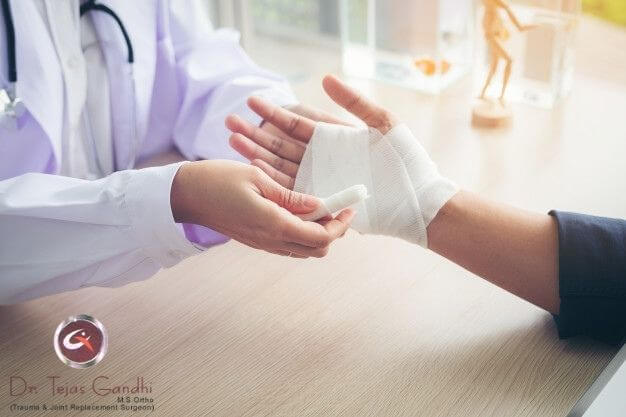Trauma Surgeon/Center


Top Trauma Center/Hospital in Ahmedabad, Gujarat
What is Trauma and Orthopedic Surgeon?
Dr. Tejas Gandhi is leading Trauma surgeon in Ahmedabad, among all top medical doctors who have trained in the field of general surgery, with a trauma surgery in specialty. Like most surgeons, trauma surgeons must complete medical school and surgical residencies to practice as a specialized trauma surgeon.
What are the 3 types of Trauma?
Three types of Trauma are:
- 1. Acute Trauma: This results from a single stressful or dangerous event that occurs in the life of a patient.
- 2. Chronic Trauma: This results from repeated and prolonged exposure to highly stressful events in the life of the patients. For Example cases of child abuse, bullying, or domestic violence.
- 3. Complex Trauma: This results from exposure to multiple traumatic events in the life of the patient.
What does an orthopedic trauma surgeon do?
Several treatments can help the patient with trauma to cope with their symptoms and improve their quality of life.
Trauma Therapy
Therapy is a first-line treatment for trauma. Ideally, the affected patient will work with a trauma informed or trauma focused therapist.
Types of therapy a patient with trauma could benefit from include:
-
Cognitive behavioral therapy:
Cognitive behavioral therapy (CBT) helps the patient to change their thought patterns in order to influence their behaviors and emotions. Evidence supports this therapy as the most effective approach for PTSD.
-
EMDR therapy:
During EMDR therapy, patients briefly relive specific traumatic experiences while the therapist directs their eye movements. EMDR aims to help people process and integrate traumatic memories and remove them from their system. Several randomized controlled trials have demonstrated that this therapy is an effective treatment for PTSD.
-
Somatic therapies:
Some therapists use somatic or body-based techniques on patients to help the mind and the body of the patient to process trauma. Somatic experiencing: This approach involves a therapist helping a person to relive traumatic memories in a safe space of their mind.
-
Sensorimotor psychotherapy:
This type of therapy combines psychotherapy with body-based techniques to turn traumatic memories into sources of strength.
-
Acupoint stimulation:
This involves a practitioner applying pressure to specific points on the body of the patients, which induces a state of relaxation.
-
Touch therapies:
Other touch therapies include Reiki, healing touch, and therapeutic touch therapy on the affected patient.
At present, there is not as much evidence to prove the effectiveness of somatic therapies or other therapies as there is for CBT and EDMR. Researchers note that more data or patient’s review will help to find how these methods work..
Medications
Actually Medication alone cannot cure trauma or PTSD, but it can help a person manage symptoms such as anxiety, depression, and sleep disturbances. A person should talk to their doctor about their feelings and experiences, this is the only way to get rid of past.General Orthopedic Trauma Surgery
Orthopedic trauma is a severe injury to the patient in part of the musculoskeletal system, such as bones, joints, or ligaments. In some cases, it presents a life-threatening medical emergency, while in others, it is in need of urgent attention but the patient is not in imminent danger of life. Trauma Treatment usually requires the services of an orthopedic surgeon and can require an orthopedic trauma specialist, someone who focuses on caring for patients in need of critical attention because of serious injuries.
What is Childhood Trauma ?
Many unfortunate children experience traumatic events throughout their lifetimes. When a child experiences trauma, it is imperative for parents or caregivers to seek out support for the child to assess the impact and develop a support plan for their child.
Types of Traumatic Events
Some situations that could be potentially traumatic for a child include the following; although this list is not exhaustive there can be more.
- Institutional racism in schools or communities or in neighbors
- Living with a parent/caregiver with significant mental illness or sickness
- Loss of a loved one due to various circumstances for example death, divorce, separation.
- Occurrences of National disasters or terrorism
- Parental incarceration/punishment
- Violence in the home, school, or community or in any institution
- Witnessing or experiencing domestic violence of any kind.
How to get over Trauma?
You must be wondering: What do trauma surgeons do? But there are several ways to deal with trauma like: Self-care Practicing self-care can help the patient to cope with the emotional, psychological, and physical symptoms of trauma. Examples of self-care for trauma include:
-
Exercise
Trauma can activate the body’s fight-or-flight response and thus relive patient’s pain. Exercise may help mitigate some of effects of trauma. Research suggests that aerobic exercise may be an effective therapy for patient with PTSD. Individuals can aim to exercise for at least 30 minutes a day or more on most days of the week.
-
Mindfulness
Mindful like breathing and other mindfulness-based exercises can ground people in the present, which can stop them from reliving the traumatic event. Studies suggest that mindfulness-based treatments are a promising intervention for PTSD, whether practiced alone or in conjunction with other treatments.
-
Connection with others
Withdrawal from people around is a common symptom of trauma. However, connecting with friends and family is important to overcome trauma. It is not necessary to talk about the trauma with other people if talking is too difficult. Simply engaging with others can improve mood and well-being of the patient. Some people feel better from disclosing the trauma with people they trust.
-
A balanced lifestyle
A patient with trauma may find it difficult to relax or to sleep well. However, sleep, relaxation, and diet all play a role in mental health. If possible, a person should try to sleep for 7–9 hours a night, eat a balanced diet, avoid alcohol and drugs, and relieve stress with mindful or enjoyable activities If necessary, people can ask for support from friends or relatives. This includes talking to trusted loved ones or joining a support group for trauma survivors/victims.
Complex Trauma Treatment
Complex trauma refers to the experience of a set of severe and sometimes pervasive adverse events that are often protracted or interpersonal in nature. Treatment of Complex Trauma includes:
- Psychotherapy for C-PTSD focuses on identifying traumatic memories and negative thought patterns and replacing them with more realistic and positive ones and learning to cope more adaptively to the impact of your trauma in patient’s life.
- Eye movement desensitization and reprocessing (EMDR) uses eye movements of the patient guided by the therapist to process and reframe traumatic memories. Over time, this process is supposed to reduce the negative feelings associated with the traumatic memory and replace it with positive ones.
- Medications may help reduce symptoms of Complex trauma, such as anxiety or depression. Medications are especially helpful when used in combination with psychotherapy.
Effects of Complex Trauma
- Difficulty controlling emotions. It's common for someone suffering from Complex trauma to lose control over their emotions, which can manifest as explosive anger, persistent sadness, depression, and suicidal thoughts.
- Negative self-view. Complex trauma can cause a person to view themselves in a negative light. They may feel helpless, guilty, or ashamed of themselves.
- Difficulty with relationships. Relationships may suffer due to difficulties trusting loved ones and a negative self-view. A person with Complex trauma may avoid relationships or develop unhealthy relationships because that is what they knew in the past.
- Detachment from the trauma. A person may disconnect from themselves and the world around them. Some people might even forget their complex trauma.
- Loss of a system of meanings. This includes losing one's core beliefs, values, religious faith, or hope in the world and other people around.
Spinal Trauma Treatment
Spinal cord treatment includes prostheses and medications that may promote nerve cell regeneration or improve the function of the nerves that remain after a spinal cord injury. Spinal cord injury treatment focuses on preventing further injury and empowering people with a spinal cord injury to return to an active and productive life.
Conclusion
You can find a trauma surgeon by typing “Trauma surgeon near me”. But not all the trauma surgeon gives the best treatment. It’s only Dr. Tejas Gandhi, who is a well known Trauma Surgeon. Arihant Hospital is the best "Trauma Centre Hospital".
Hip Arthroscopy Recovery Time
Symptoms often improve immediately following the procedure, but recurrence of some pain can occur as the irritated joint lining heals, and temporary tenderness in the hip and knee from the traction may occur to the patient.
You may also feel a sensation of water in the hip or hear gurgling noises resulting from the fluid used during surgery, but this will quickly be absorbed by the body and within few days it won’t cause any problem. Swelling in the affected area should subside within about a week and any sutures will typically be removed in seven to ten days. Your full recovery time may vary, depending on the specific treatment performed during your procedure and the amount of damage caused in the hip. After the recover you will be able to do all the activities.
Can you sit after hip arthroscopy ?
Yes, you can sit after Hip arthroscopy. Hip arthroscopy patients must usually use crutches for one or two weeks after surgery and do six weeks of physical therapy. It may be three to six months before they experience no pain after physical activity.
How do you sleep after hip arthroscopy ?
All the instructions will be given by the surgeon who has conducted your operation or the physical therapist. You don’t need to search for “Hip Arthroscopy Specialists near Me” Because there is only one Arthroscopy specialist and that is “Dr. Tejas Gandhi”.



